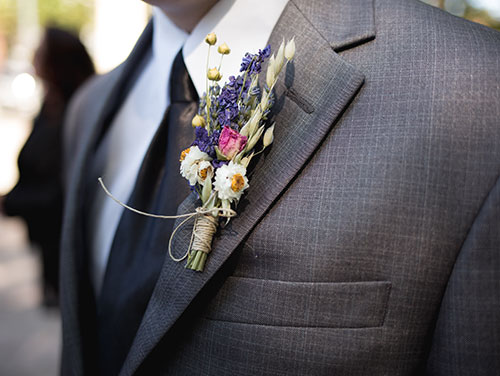 Wedding buttonhole and boutonniere are cute groom’s accessories. You can choose either for your wedding. If you want to add a fancy look to your marriage ceremony, think about making the groom’s and groomsmen’s boutonnieres and the bride’s and bridesmaids’ bouquets in a similar style. Though, the couple’s florals should stand out infallible among other flower arrangements. But let’s get back to the buttonholes and boutonnieres. How are they different? What materials are the best for them? How to wear them correctly? Find out below.
Wedding buttonhole and boutonniere are cute groom’s accessories. You can choose either for your wedding. If you want to add a fancy look to your marriage ceremony, think about making the groom’s and groomsmen’s boutonnieres and the bride’s and bridesmaids’ bouquets in a similar style. Though, the couple’s florals should stand out infallible among other flower arrangements. But let’s get back to the buttonholes and boutonnieres. How are they different? What materials are the best for them? How to wear them correctly? Find out below.
Difference between buttonhole and boutonniere
These two items are very similar. Their purpose is the same but the design is a bit different. A buttonhole and a boutonniere both are wedding accessories of a groom. They match the bridal bouquet and are worn pinned to the buttonhole or lapel of a groom’s suit jacket, tuxedo, or vest.

Groom's boutonniere
A buttonhole consists of a single central flower. Sometimes, it can be accompanied by a bit of foliage, but this one flower remains the central accent.
A boutonniere is usually a cluster of flowers or other elements, sort of like a tiny bouquet. It can consist of a few flowers, fruits, herbs, etc. But it’s always an arrangement of items, not a single item.

Groom's buttonhole
Both a buttonhole and a boutonniere are lovely and very popular accessories used by grooms at lots of weddings. This little arrangement can be created in any style and can highlight the groom’s personality. Also, the cute pair of a wedding bouquet and a wedding buttonhole / boutonniere visually unites the bride and groom and makes them stand out of the crowd.
Fresh or artificial flowers
There is a wide variety of choices for a buttonhole or boutonniere, including fresh flowers, different herbs and greenery, fruits, berries, artificial flowers, or even various weirder items, like plastic toys, candies, buttons, etc. It’s only up to you what kind of a groom’s accessory to choose. Still, the most widespread are buttonholes and boutonnieres made from fresh or artificial flowers.

Another groom's boutonniere
If you decide to use fresh flowers, make sure they can survive for many hours without water and not fade. Also, they must withstand a lot of contact because the groom hugs with other people all of the time, touches the buttonhole with a sleeve, and so on. Usually, it’s roses, carnations, waxflowers, or some other hardy florals. Fruits, greenery, and berries also last long and are a perfect choice.
Another option is to pick artificial flowers. Today, they can be rather high-quality and look realistic. For example, silk flowers. They won’t fade or lose fine appearance. You just pin it and forget about it.
How to wear buttonholes and boutonnieres
Male buttonholes and boutonnieres are pinned to the suit jacket on the left lapel. The head should be pointing upwards toward the left shoulder. Don’t pull the arrangement through the actual buttonhole of a jacket, just pin it to the fabric. The pin should be hidden on the underside of the lapel.

Male boutonnieres made from artificial flowers, wax beads, and ribbons. These are modern replicas of authentic Ukrainian boutonnieres from the 19th-early 20th century
Buttonholes and boutonnieres are being used by grooms for centuries. In many countries, lovely vintage groom’s accessories survived and are now exhibited in museums. The style and design of boutonnieres change from time to time, along with wedding bouquet trends. But no matter what the trend is at the moment, you’re always free to choose the design you like.

